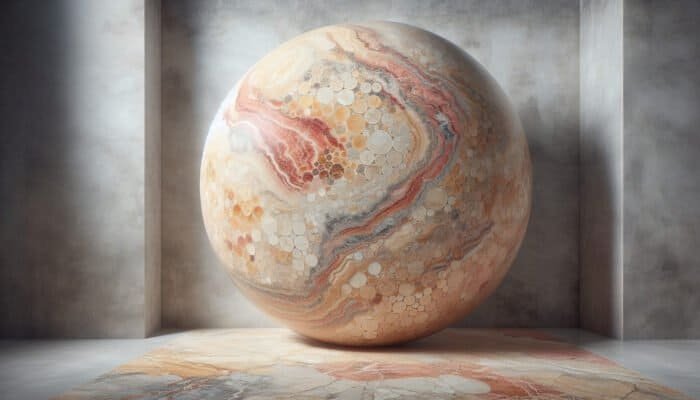Unveiling the Aesthetic and Practical Benefits of Travertine Flooring
Appreciating the Natural Beauty of Travertine: A Stone Like No Other

Travertine is an extraordinary form of limestone that has formed through the natural deposition of mineral-rich hot spring water, predominantly consisting of calcium carbonate. This remarkable stone is celebrated for its distinctive layered structure and natural pockmarks, which greatly enhance its visual appeal, making it a popular choice for both home and business environments. Across the UK, travertine showcases a breathtaking spectrum of colours, from creamy beige to opulent gold, infusing any space with a sense of elegance that beautifully complements diverse interior styles. Beyond its stunning aesthetics, the sturdy nature of travertine makes it an excellent option for high-traffic areas, retaining its integrity over time while adding warmth and character to any environment.
Travertine is derived from natural hot springs, with notable deposits located in regions such as Italy and Turkey. However, its natural porosity can make it prone to staining if not properly cared for. This underscores the vital necessity of <a href="https://tilecleaningsurrey.co.uk/tile-care/effective-travertine-tile-cleaning-simple-guide-a-uk-homeowners-essential-tips/">travertine floor sealing</a> to maintain and enhance its allure. By understanding the essence of travertine, homeowners can appreciate the importance of protecting this magnificent material, ensuring its charm and functionality endure for generations to come.
Discovering the Remarkable Advantages of Travertine Flooring
Opting for travertine flooring in both residential and commercial properties provides a multitude of benefits that go beyond mere visual aesthetics. One of the most striking advantages is its timeless elegance; travertine radiates sophistication, capable of transforming any space. Whether it’s a stylish apartment in London, a quaint cottage in the countryside, or a sleek modern office, travertine adds a touch of style and refinement that significantly enhances the overall atmosphere and appeal of the environment.
The exceptional durability of travertine flooring serves as another compelling reason to consider it for your spaces. Unlike many other flooring materials that may warp or crack over time, travertine is built to withstand substantial wear and tear, making it a reliable choice for bustling households or busy commercial settings. Furthermore, its inherent thermal properties provide excellent insulation, contributing to the maintenance of a comfortable indoor climate, regardless of the weather conditions outside.
In addition, travertine flooring demonstrates remarkable versatility, seamlessly fitting into a broad spectrum of interior design styles, from contemporary minimalism to classic traditional aesthetics. Its ability to complement various decor elements makes it a highly sought-after choice among architects and interior designers in the UK, who value its adaptability and timeless charm that continues to captivate homeowners and guests alike.
Versatile Uses of Travertine in British Homes
In the UK, travertine is widely embraced, with homeowners captivated by its unique qualities throughout different areas of their living spaces. Living rooms, in particular, benefit from travertine’s natural charm, fostering a warm and inviting atmosphere that is ideal for family gatherings or entertaining friends. The stone's visual appeal is further enhanced by its durability, making it suitable for high-traffic areas where resilience is essential for maintaining a pristine look.
Kitchens also represent optimal environments for travertine flooring, providing a robust foundation for culinary enthusiasts. Its inherent heat resistance, coupled with its ability to withstand spills and stains, makes it a practical choice for passionate cooks. Moreover, the natural cooling properties of travertine offer a comfortable surface to walk on, particularly during the sweltering summer months when comfort is paramount.
Bathrooms frequently feature travertine flooring as well, where its sophisticated presence can elevate an ordinary space into a luxurious retreat. When appropriately sealed, the stone's moisture resistance ensures it remains in excellent condition while contributing to a tranquil and stylish atmosphere. This versatility has solidified travertine's status as a leading option for homeowners aiming to enhance both the aesthetics and functionality of their living areas.
The Vital Necessity of Sealing Travertine for Enduring Beauty

Protecting Against Unwanted Stains
Sealing travertine is crucial for protecting it against unsightly stains that can occur from everyday use. The porous nature of travertine allows liquids such as red wine, coffee, and oil to easily penetrate its surface, potentially leading to permanent discolouration if not managed quickly. A high-quality sealant acts as a protective barrier, preventing these substances from seeping into the stone and greatly simplifying the cleaning process.
In numerous homes across the UK, where travertine is commonly installed in areas prone to spills, the importance of sealing cannot be overstated. Homeowners can find comfort in knowing that their beautiful floors are safeguarded against the challenges of daily life. For example, in a busy kitchen, where the risk of accidental spills is high, sealing becomes an essential step in preserving the stone’s pristine appearance and functionality.
Moreover, sealing significantly reduces the frequency of deep cleaning required to maintain travertine floors. By preventing stains from embedding themselves, homeowners can focus on routine maintenance tasks rather than combating stubborn blemishes. This not only saves valuable time but also protects the investment made in exquisite travertine flooring.
Extending the Lifespan of Travertine Flooring
While the durability of travertine flooring is widely acknowledged, proper sealing further enhances that durability. A quality sealant strengthens the stone, adding an extra layer of protection against scratches, chips, and everyday wear and tear. In high-traffic areas where foot activity is common, this additional durability becomes particularly vital.
Sealing also prolongs the lifespan of travertine floors by minimising deterioration caused by moisture infiltration. In regions of the UK that experience heavy rainfall, such as the Lake District or specific areas of Wales, moisture can severely damage unsealed stone surfaces. In such instances, sealing acts as a protective barrier against water damage and mould growth, ensuring the floor remains in optimal condition.
Furthermore, a well-sealed travertine floor can maintain its natural beauty for many years, preserving its original charm and elegance. With the right sealant, homeowners can expect their travertine floors to withstand the rigours of daily living while consistently appearing stunning and inviting.
Maintaining the Visual Appeal of Travertine

The visual allure of travertine flooring is undoubtedly one of its most enchanting features; however, this beauty can diminish over time without appropriate care. Sealing plays a vital role in enhancing and preserving the stone’s natural colours and textures, ensuring that a travertine floor remains attractive for years to come. When properly sealed, travertine retains its vibrant hues and distinctive patterns, preventing the dullness that can result from dirt accumulation and wear over time.
An unsealed travertine floor can quickly become a magnet for grime, leading to a lacklustre appearance that detracts from its inherent charm. By investing in travertine floor sealing, homeowners can protect the stone’s elegance while simplifying cleaning efforts. A sealed floor resists dirt buildup, facilitating effortless maintenance that helps preserve its aesthetic integrity and prolong its lifespan.
Additionally, sealed travertine surfaces exhibit a subtle sheen that enhances their sophistication without appearing overly glossy. This natural lustre can elevate the overall ambience of a room, creating a more refined and luxurious atmosphere. Homeowners eager to impress guests or cultivate a welcoming environment will find that sealing their travertine is a crucial step in showcasing its beauty effectively.
Mitigating Damage from Moisture
Moisture poses one of the most significant threats to the integrity of travertine flooring. When water seeps into the porous surface, it can lead to various issues, including cracks, warping, and the proliferation of mould and mildew. These complications not only undermine the aesthetic appeal of travertine but can also jeopardise its structural integrity over time if left unaddressed.
Sealing travertine serves as a proactive measure against moisture damage, creating a solid barrier that prevents water from penetrating the stone. Given the damp conditions often encountered in the UK, sealing becomes increasingly essential. Properly sealed floors are less likely to suffer from the negative effects of humidity and moisture, ensuring longevity and durability.
Moreover, the benefits of moisture protection extend to the overall health of the home. Mould and mildew growth can lead to respiratory issues and other health concerns, especially in confined spaces such as bathrooms or basements. By sealing travertine, homeowners promote a healthier indoor environment while effectively safeguarding their investment in beautiful flooring.
Simplifying Cleaning and Maintenance Tasks
The practical benefits of sealing travertine are considerable, particularly regarding maintenance. A sealed surface is substantially easier to clean than an unsealed one, as dirt and grime cannot penetrate the stone. This advantage is especially advantageous for busy households in the UK, where time for deep cleaning may be limited and precious.
With a sealed travertine floor, regular cleaning routines become more efficient. Homeowners can simply sweep or mop the surface without the worry of scratching or damaging the stone. Liquid spills can be wiped up quickly, minimising the risk of stains and facilitating prompt clean-up after everyday accidents and mishaps.
Furthermore, a sealed travertine floor can enhance hygiene levels within the home. Since dirt does not seep into the surface, it is less likely to harbour bacteria and allergens, contributing to a healthier living environment. This feature is particularly crucial in family homes or among individuals with allergies, making travertine floor sealing a wise investment for overall cleanliness and comfort in residential spaces.
Crucial Steps for Preparing Travertine for Effective Sealing
Meticulously Cleaning the Travertine Surface for Optimal Results
Before commencing the sealing process, it is imperative to thoroughly clean the travertine surface. This foundational step ensures that all dirt, dust, and debris are eliminated, allowing the sealant to adhere effectively. A well-prepared surface is essential; any remaining residue can compromise the overall effectiveness of the sealant, leading to unsatisfactory results and diminished longevity.
Homeowners should begin by sweeping or vacuuming the travertine floor to remove loose dirt and particles. Following this, a suitable stone cleaner should be employed to deep clean the surface, effectively removing ingrained grime and stains. It is vital to select a cleaner specifically formulated for use on natural stone to avoid causing damage to the travertine during the cleaning process.
After cleaning, rinsing the surface with clean water is necessary to eliminate any cleaner residue before allowing the travertine to dry completely. This preparation phase is crucial for ensuring optimal adhesion for the sealant, setting the stage for a successful sealing process that protects and preserves the beauty of the travertine for years to come.
Addressing Existing Damages Before Sealing
Prior to applying the sealant, it is critical to address any pre-existing damages in the travertine. Cracks, chips, or holes can interfere with the sealing process, leading to uneven coverage and potentially compromising the floor’s integrity. Properly repairing these damages not only enhances the travertine’s appearance but also ensures that the sealant provides maximum protection and longevity.
For minor cracks or holes, homeowners can utilise a suitable travertine repair kit, typically containing a resin filler specifically designed for natural stone. Following the manufacturer’s instructions for applying the filler will help create a smooth and uniform surface, primed for sealing.
Additionally, it is advisable to assess the surrounding areas for any loose tiles or pieces of travertine that may require reaffixing. This meticulous attention to detail ensures a consistent and effective sealing process, allowing homeowners to enjoy the full benefits of their travertine flooring without the worry of hidden imperfections undermining its beauty and functionality.
Choosing the Optimal Time for Sealing Travertine
The timing of the sealing process is critical for achieving the best results. Homeowners should ideally select a dry and mild day for sealing, as humidity and extreme temperatures can adversely affect the curing process of the sealant. In the UK, autumn or spring may provide optimal weather conditions, as these seasons typically offer more stable temperatures and reduced humidity levels.
Before commencing the sealing process, it is essential to review the weather forecast to ensure that no rain or significant temperature fluctuations are anticipated. Applying sealant under unsuitable conditions can yield unsatisfactory outcomes, such as incomplete curing or a surface that fails to adhere properly.
Planning ahead and allowing ample time for the sealing process to be completed without haste is also vital. Rushing through the application can lead to uneven coverage or missed spots, detracting from the overall finish. Considering these factors will help ensure a successful sealing experience that enhances both the longevity and appearance of the travertine flooring.
Utilising Primer for Improved Adhesion of Sealant
For optimal results during sealant application, using a primer specifically designed for travertine can significantly enhance adhesion. The primer acts as a bonding agent, ensuring that the sealant adheres correctly to the stone surface, ultimately providing a more durable and long-lasting finish.
Before applying the primer, ensure that the travertine is clean and dry to promote effective adhesion. Using a brush or roller, apply the primer evenly across the surface, paying particular attention to seams or joints where moisture may penetrate. Allow the primer to cure according to the manufacturer’s instructions before proceeding with the sealant application.
This additional step helps create a robust, protective barrier that ultimately extends the lifespan of the travertine while ensuring it continues to look beautiful over time. Homeowners who invest time in applying primer will discover that their sealed travertine floors possess an enhanced level of protection and aesthetic appeal, ensuring lasting satisfaction.
Protecting Surrounding Areas During the Sealing Process
Before initiating the sealing process, it is crucial to safeguard the adjacent areas of the home. Sealant can easily splatter or spill onto surrounding surfaces, potentially causing damage or creating unsightly messes that can be difficult to clean. Taking the time to mask off or cover nearby areas will ensure a smooth sealing process with minimal unintended consequences.
Utilising painter’s tape to cover baseboards, edges, or any areas adjacent to the travertine can provide an effective barrier against sealant. Additionally, employing drop cloths or old sheets to shield furniture and fixtures will protect them from any accidental spills.
By prioritising this preparation step, homeowners can focus on the sealing process itself, confident that their home is safeguarded against potential messes. This meticulous attention to detail is instrumental in achieving a professional-looking finish that enhances the overall appeal of the travertine flooring.
Examining Various Sealant Options for Travertine Flooring
Comprehensive Overview of Penetrating Sealants for Travertine Protection
When considering travertine floor sealing, penetrating sealants remain a popular choice among homeowners for their effectiveness. These sealants penetrate the porous surface of the travertine, offering deep protection against stains and moisture. Unlike topical sealants that create a barrier on the surface, penetrating sealants allow the stone to retain its natural texture and appearance while providing robust protection against potential damage.
One of the primary advantages of penetrating sealants is their long-lasting effectiveness. Once correctly applied, they can endure for several years, thereby minimising the frequency of reapplications needed. This is particularly advantageous in busy households where maintenance time is often limited. Additionally, penetrating sealants do not alter the colour of the travertine, preserving the stone’s intrinsic beauty while providing the necessary protection it demands.
In the UK, where unpredictable weather conditions are a common occurrence, penetrating sealants are particularly effective in safeguarding travertine flooring against moisture damage. By preventing water from infiltrating the stone, these sealants help mitigate the risk of mould and mildew growth, ensuring that the floors remain in optimal condition for an extended period.
Understanding Topical Sealants for Enhanced Travertine Protection
Topical sealants present another option for safeguarding travertine flooring, functioning by forming a protective layer on the surface of the stone. This layer not only enhances the stone’s shine but can also impart a polished appearance, making it an attractive choice for homeowners looking to elevate the aesthetic of their space.
While topical sealants can provide excellent protection against stains and moisture, they typically necessitate more frequent reapplication compared to penetrating sealants. This is largely because the protective layer wears down over time, particularly in high-traffic areas. For homeowners in the UK, where foot traffic may be considerable, understanding the maintenance requirements of topical sealants is crucial for ensuring the long-lasting protection of their travertine floors.
It’s important to note that while topical sealants can enhance the shine and appearance of travertine, they might alter the stone’s natural look. Therefore, homeowners should carefully weigh their desire for a glossy finish against the need to maintain the stone’s original character and charm.
Advantages of Using Enhancing Sealants for Travertine
Enhancing sealants are specifically formulated to elevate the visual allure of travertine flooring while providing additional protection. These sealants not only guard against stains and moisture but also enrich the colours and patterns of the stone, revealing its natural beauty. For those desiring a vibrant, polished look for their travertine floors, enhancing sealants offer an excellent solution.
In the context of UK homes, enhancing sealants can dramatically transform a dull travertine surface into a striking focal point. The application process remains similar to that of traditional sealants, but the results can be remarkable, with the stone appearing more vibrant and alive, thereby enhancing the overall aesthetic of the space.
However, homeowners should be mindful that enhancing sealants often require more regular maintenance, as their surface layer may wear off faster than penetrating sealants. This consideration is particularly vital for busy households where foot traffic is high, making consistent upkeep a crucial aspect of preserving the beauty and functionality of travertine floors.
Effective Techniques for Applying Travertine Sealants
Applying Sealant with Precision Using a Brush Technique
One of the most effective methods for applying sealant to travertine flooring is through the use of a brush. This technique allows homeowners to achieve an even distribution of sealant across the surface, ensuring that every crevice and pore is adequately covered. For smaller areas or intricate designs, brushing is often the best approach due to the precision and control it provides during application.
When brushing on sealant, it’s crucial to use a high-quality, natural-bristle brush that can effectively work the sealant into the stone. Begin at one corner of the room and methodically progress across the surface, applying a thin, even layer. This approach helps prevent pooling or excess sealant, which can lead to an uneven finish that detracts from the overall look of the floor.
Another advantage of brushing on sealant is the ability to closely monitor the application. Homeowners can easily adjust their technique based on the stone’s texture and any areas that may require additional attention. This level of control is particularly beneficial for those unfamiliar with the sealing process, as it allows for corrections along the way and ultimately leads to a more professional finish.
Rolling on Sealant for Quick and Efficient Coverage
For homeowners with larger areas to cover, rolling on sealant can be a time-saving and efficient technique. Using a foam roller allows for rapid and uniform application of sealant across expansive travertine surfaces, minimising the time and effort required for the task while ensuring comprehensive coverage.
Before rolling on sealant, it is crucial to ensure that the surface is clean, dry, and free from debris to prevent any imperfections in the finish. Start at one end of the room and work across in sections, applying a consistent amount of sealant as you proceed. This method facilitates swift application while still ensuring full coverage and an aesthetically pleasing finish.
One of the key benefits of rolling on sealant is the ability to cover large areas in a fraction of the time it would take to brush. However, homeowners should remain vigilant during the application process, checking for spots that may require additional sealing or uneven coverage. By maintaining a careful eye, this technique can yield impressive results while significantly reducing the time spent on the project, making it ideal for larger homes or commercial spaces.
Utilising Spray Application for Hard-to-Reach Areas
For those with intricate designs or difficult-to-reach areas, spraying on sealant can provide an effective solution. This method involves using a sprayer to apply a fine mist of sealant, ensuring even coverage without the risk of over-saturation. For homeowners aiming for a consistent finish, spraying can be an advantageous technique that saves time and effort.
Before beginning, ensure the area is well-ventilated, as sealant fumes can be potent. It’s also essential to wear appropriate protective gear, including a mask and gloves, to safeguard against inhalation and skin contact. Prepare the sprayer according to the manufacturer’s instructions and test the spray pattern on a small, inconspicuous area before proceeding with the application.
When spraying, maintain a consistent distance from the travertine surface to ensure even application. Work in sections, overlapping each pass slightly to avoid missed spots while maintaining a uniform layer. This method can be particularly beneficial for homeowners with larger projects or those seeking to achieve a flawless finish, allowing for a smooth and efficient sealing process.
Understanding the Drying and Curing Process After Sealing
Grasping Drying Times for Maximum Sealant Effectiveness
Once the sealant is applied to the travertine flooring, understanding the drying times is critical for ensuring optimal results. Different sealants may have varying drying times, making it essential to adhere to the manufacturer’s recommendations for the specific product being used. Generally, most sealants require a few hours to dry sufficiently before foot traffic can safely resume.
During this drying period, it is vital to avoid walking on the newly sealed surface to prevent any imprinting or smudging that could mar the finish. Homeowners should also keep pets and children away from the area to allow the sealant to set properly, ensuring lasting protection against stains and moisture.
In the context of UK weather, humidity can significantly influence drying times. In more humid conditions, such as during summer months, drying may take longer than anticipated. Homeowners should consider weather forecasts and plan their sealing project accordingly to ensure optimal conditions for drying, thereby enhancing the performance and longevity of the sealant applied.
The Significance of Curing After Sealant Application
Curing is a crucial phase that follows the drying of the sealant, allowing the product to fully bond with the travertine surface. This process can take several days, during which the sealant hardens and provides the necessary protection against moisture and stains. It is essential to refrain from heavy foot traffic during this period to ensure that the sealant cures completely and effectively.
While the surface may feel dry to the touch after a few hours, it is important to remember that full curing could take up to a week or longer, depending on the specific sealant used and environmental conditions. To achieve the best results, homeowners should ensure that the temperature remains stable and that the area is well-ventilated to facilitate curing, thereby maximising the protective benefits of the sealant.
Monitoring the curing process closely can also assist homeowners in identifying any issues that may arise. If the sealant appears to be taking longer to cure than expected, checking humidity levels or consulting the manufacturer for guidance may prove beneficial in ensuring that the sealing process is successful.
Conducting a Simple Water Test to Verify Sealant Effectiveness
Once the recommended drying and curing times have passed, homeowners can perform a straightforward water test to verify the effectiveness of the sealant. This test involves placing a few drops of water on the sealed travertine surface. If the water beads up instead of soaking in, it indicates that the sealant is functioning correctly and providing the necessary protection against moisture.
Should the water absorb into the travertine, it may indicate the need for additional sealing or that the initial application was inadequate. In such cases, homeowners should consider reapplying the sealant according to the manufacturer’s instructions to ensure optimal protection for their travertine flooring and to maintain its stunning appearance.
Conducting this simple test is an effective way to verify the success of the sealing process, providing homeowners with peace of mind that their beautiful travertine floors are adequately protected against moisture, stains, and the wear and tear of everyday life.
Frequently Asked Questions Regarding Travertine Flooring
What materials comprise travertine flooring?
Travertine flooring is a natural stone product derived from limestone, characterised by its distinctive texture and impressive durability. It is favoured for its elegant appearance and is commonly used in both residential and commercial settings, elevating the aesthetic of any environment.
How frequently should I seal my travertine floors?
Typically, it is recommended to seal travertine floors every one to three years, depending on foot traffic levels and exposure to liquids. Regular inspections will help determine the appropriate sealing schedule based on the specific needs of the flooring.
Can I use regular cleaners on travertine flooring?
No, standard cleaners may damage travertine. It is critical to use cleaning products specifically formulated for natural stone to preserve its beauty and integrity, ensuring that the travertine maintains its stunning appearance over time.
Which types of sealants work best for travertine?
The best types of sealants for travertine include penetrating sealants for deep protection and topical sealants for enhanced surface shine. Choosing the right sealant ultimately depends on the desired appearance and maintenance preferences of the homeowner.
What is the proper method for cleaning travertine floors?
To clean travertine floors, begin by sweeping or vacuuming to eliminate dirt, then utilise a pH-neutral stone cleaner with a soft mop or cloth. It is essential to avoid abrasive tools that could scratch the surface and compromise the integrity of the stone.
Is sealing travertine necessary for maintenance?
Yes, sealing travertine is essential to protect it from stains, moisture damage, and wear, ensuring its longevity and maintaining its natural beauty for years to come. This proactive measure significantly enhances the performance of the flooring.
Can I apply sealant on my own?
Yes, many homeowners choose to apply sealant independently; however, it is crucial to follow the manufacturer’s instructions carefully to achieve the best results. Proper preparation and application techniques are vital for ensuring a successful sealing process.
What should I do if my travertine is stained?
If your travertine is stained, it may be necessary to use a specialised stone cleaner or a poultice to address the stain before sealing. Consulting a professional is advisable for severe stains to ensure the best possible outcome.
How long does the sealing process take to complete?
The sealing process generally requires a few hours for application and several days for full curing. Homeowners should plan accordingly and avoid heavy foot traffic during this period to ensure optimal results and longevity.
Is it possible to change the colour of my travertine with sealant?
Enhancing sealants can enrich the natural colours of travertine, but they may not significantly alter its colour. For more notable colour changes, consider professional treatment or dyeing options to achieve the desired effect.
The post Travertine Floor Sealing: A Comprehensive Guide appeared first on https://tilecleaningsurrey.co.uk
The Article Travertine Floor Sealing: The Essential Guide You Need appeared first on https://fabritec.org
The Article Essential Guide to Travertine Floor Sealing Was Found On https://limitsofstrategy.com

